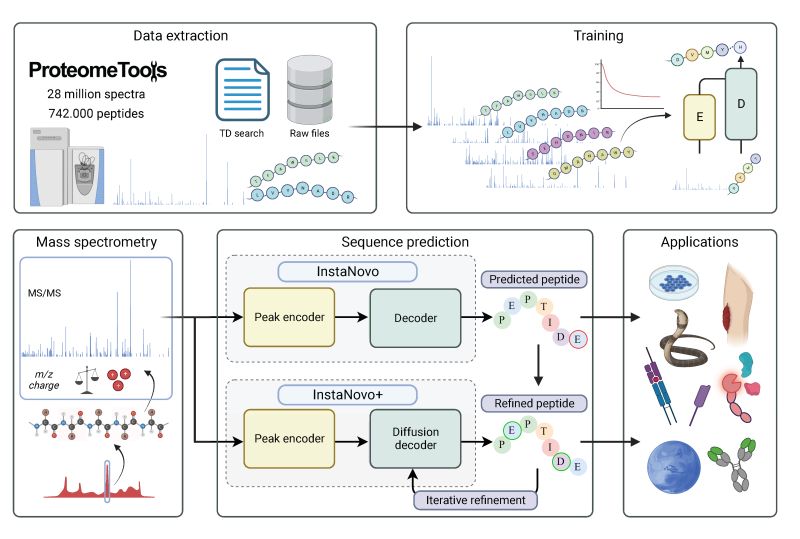The official code repository for InstaNovo. This repo contains the code for training and inference of InstaNovo and InstaNovo+. InstaNovo is a transformer neural network with the ability to translate fragment ion peaks into the sequence of amino acids that make up the studied peptide(s). InstaNovo+, inspired by human intuition, is a multinomial diffusion model that further improves performance by iterative refinement of predicted sequences.
Links:
Developed by:
To use InstaNovo, we need to install the module via pip:
pip install instanovoIt is recommended to install InstaNovo in a fresh environment, such as Conda or PyEnv. For example, if you have conda/miniconda installed:
conda env create -f environment.yml
conda activate instanovoNote: InstaNovo is built for Python >= 3.8
To train auto-regressive InstaNovo:
usage: python -m instanovo.transformer.train train_path valid_path [-h] [--config CONFIG] [--n_gpu N_GPU] [--n_workers N_WORKERS]
required arguments:
train_path Training data path
valid_path Validation data path
optional arguments:
--config CONFIG file in configs folder
--n_workers N_WORKERSNote: data is expected to be saved as Polars .ipc format. See section on data conversion.
To update the InstaNovo model config, modify the config file under configs/instanovo/base.yaml
To evaluate InstaNovo:
usage: python -m instanovo.transformer.predict data_path model_path [-h] [--denovo] [--config CONFIG] [--subset SUBSET] [--knapsack_path KNAPSACK_PATH] [--n_workers N_WORKERS]
required arguments:
data_path Evaluation data path
model_path Model checkpoint path
optional arguments:
--denovo evaluate in de novo mode, will not try to compute metrics
--output_path OUTPUT_PATH
Save predictions to a csv file (required in de novo mode)
--subset SUBSET
portion of set to evaluate
--knapsack_path KNAPSACK_PATH
path to pre-computed knapsack
--n_workers N_WORKERSTo use your own datasets, you simply need to tabulate your data in either Pandas or Polars with the following schema:
The dataset is tabular, where each row corresponds to a labelled MS2 spectra.
sequence (string) [Optional]
The target peptide sequence excluding post-translational modificationsmodified_sequence (string)
The target peptide sequence including post-translational modificationsprecursor_mz (float64)
The mass-to-charge of the precursor (from MS1)charge (int64)
The charge of the precursor (from MS1)mz_array (list[float64])
The mass-to-charge values of the MS2 spectrummz_array (list[float32])
The intensity values of the MS2 spectrum
For example, the DataFrame for the nine species benchmark dataset (introduced in Tran et al. 2017) looks as follows:
| sequence | modified_sequence | precursor_mz | precursor_charge | mz_array | intensity_array | |
|---|---|---|---|---|---|---|
| 0 | GRVEGMEAR | GRVEGMEAR | 335.502 | 3 | [102.05527 104.052956 113.07079 ...] | [ 767.38837 2324.8787 598.8512 ...] |
| 1 | IGEYK | IGEYK | 305.165 | 2 | [107.07023 110.071236 111.11693 ...] | [ 1055.4957 2251.3171 35508.96 ...] |
| 2 | GVSREEIQR | GVSREEIQR | 358.528 | 3 | [103.039444 109.59844 112.08704 ...] | [801.19995 460.65268 808.3431 ...] |
| 3 | SSYHADEQVNEASK | SSYHADEQVNEASK | 522.234 | 3 | [101.07095 102.0552 110.07163 ...] | [ 989.45154 2332.653 1170.6191 ...] |
| 4 | DTFNTSSTSNSTSSSSSNSK | DTFNTSSTSN(+.98)STSSSSSNSK | 676.282 | 3 | [119.82458 120.08073 120.2038 ...] | [ 487.86942 4806.1377 516.8846 ...] |
For de novo prediction, the modified_sequence column is not required.
We also provide a conversion script for converting to Polars IPC binary (.ipc):
usage: python -m instanovo.utils.convert_to_ipc source target [-h] [--source_type {mgf,mzml,csv}] [--max_charge MAX_CHARGE] [--verbose]
positional arguments:
source source file or folder
target target ipc file to be saved
optional arguments:
-h, --help show this help message and exit
--source_type {mgf,mzml,csv}
type of input data
--max_charge MAX_CHARGE
maximum charge to filter outNote: we currently only support mzml, mgf and csv conversions.
If you want to use InstaNovo for evaluating metrics, you will need to manually set the
modified_sequence column after conversion.
This code repo is currently under construction.
ToDo:
- Add data preprocessing pipeline
- Multi-GPU support
Code is licensed under the Apache License, Version 2.0 (see LICENSE)
The model checkpoints are licensed under Creative Commons Non-Commercial (CC BY-NC-SA 4.0)
@article{eloff_kalogeropoulos_2023_instanovo,
title = {De novo peptide sequencing with InstaNovo: Accurate, database-free peptide identification for large scale proteomics experiments},
author = {Kevin Eloff and Konstantinos Kalogeropoulos and Oliver Morell and Amandla Mabona and Jakob Berg Jespersen and Wesley Williams and Sam van Beljouw and Marcin Skwark and Andreas Hougaard Laustsen and Stan J. J. Brouns and Anne Ljungars and Erwin Marten Schoof and Jeroen Van Goey and Ulrich auf dem Keller and Karim Beguir and Nicolas Lopez Carranza and Timothy Patrick Jenkins},
year = {2023},
doi = {10.1101/2023.08.30.555055},
publisher = {Cold Spring Harbor Laboratory},
URL = {https://www.biorxiv.org/content/10.1101/2023.08.30.555055v3},
journal = {bioRxiv}
}